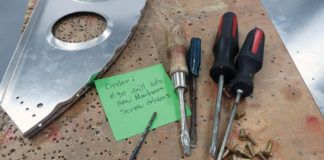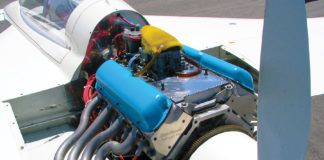AeroLectrics columns represent a pretty heavy-duty set of articles about the technical side of making the avionics of an airplane. I thought perhaps after nearly 20 years of monthly and semi-monthly columns a little horseplay might be in order. Herewith, a few offerings to remind us that it is good to laugh at ourselves from time to time. (The last articles I did in this vein were in Private Pilot magazine, April 1979, “The Co-Tanger Antenna” and KITPLANES, December 1995, “Using Your $15,000 Aircraft Oven: Engine Cookery at Altitude”).
Websters Versus the FAA
After nearly 50 years as a certificated sky-machine driver and over 30 years with a greasy wrenchs ticket in my pocket, Ive learned to take the drivel coming out of Oklahoma City and Washington with a grain of salt. Ive been aware that most communications with government agencies (especially those that regulate the flinging of large, heavy objects into the sky) would make just as much sense carried on in cuneiform as in English.
Understand that a government regulating agency has one interpretation of its words, and you as the regulatee have another meaning, generally diametrically divergent, for those same communications. Therefore, when dealing with the FAA, keep in mind that what you heard is usually not what they meant.
However, if you take this lexicon with you to your next confrontation with the Friendly Aviation Agency, you will readily see that what you thought they meant is not what you heard them say. Capiche?
What the FAA Said Versus What It Meant
Said: Your application is in process and I don’t see any major problems with it.
Meant: Your application is so wrapped up in red tape you couldn’t cut it with a machete.
Said: Your project is generating a small program.
Meant: We have bought a new office, staffed it with a hundred people, a new tax has been proposed, and the President has been advised. You will be billed for the program before we issue the approvals.
Said: We are looking into it.
Meant: We were hoping that by the time we found an answer, nobody at your place would remember why you asked the question.
Said: We will expedite it.
Meant: We will confound confusion with commotion.
Said: Official channels.
Meant: The desk between two
expediters.
Said: We have activated your file.
Meant: We’ve made a hundred copies and added everybody in the office to the memo list.
Said: We will iron out our differences.
Meant: So long as it doesn’t change what we have already decided to do.
Said: We will be in touch.
Meant: We don’t have a clue, but if we ever figure it out, well let you know.
Said: We are aware of your situation.
Meant: And we were kind of hoping you had forgotten about the problem
by now.
Said: The item is open to interpretation.
Meant: Hey, buddy, its your warped interpretation against the FAAs good sense.
Said: We have analyzed the situation.
Meant: We’ve drawn a geometrically precise line from an unwarranted assumption through an unreliable data point to a foregone conclusion.
Said: Our best engineer has been assigned to your project.
Meant: Old Charley, who couldn’t find his hiney in a phone booth with both hands, will be with you just as soon as he finishes the Cessna 171 project he started back in 1953.
Said: We are processing your application.
Meant: We’ve bounced it back and forth between Oklahoma City and Washington so often it fell out of sight somewhere around Kentucky.
Said: It is under consideration.
Meant: Nobody in the office remembers anything about it.
Said: It is under active consideration.
Meant: We are searching the dead files for it.
Said: Lets have a private meeting on your project.
Meant: Lets substitute unverifiable conversation for the dreariness of hard work and the loneliness of original thought.
Said: Id like a meeting of the minds.
Meant: Id like a knocking of heads.
Said: We heard it from a reliable source.
Meant: We heard it in the Aero Club bar last night.
Said: We heard it from an unimpeachable source.
Meant: We heard it from the guy that actually started the rumor.
Said: We need a clarification.
Meant: We are going to fill in the background with so much clutter and detail that the foreground goes underground.
Said: We are surveying your problem.
Meant: We are stalling for time until we come up with an answer that covers our tracks.
Said: We’ve made a note and initial memo among our staff.
Meant: Were getting everybody in the building responsible for this turkey.
Said: Lets get together and discuss the problem.
Meant: Come on up Thursday. The guy who really can help you will be out to lunch with my secretary and Ill be lonely.
Said: Lets hash out the details.
Meant: Cmon, give us a clue. Nobody in the office has the foggiest idea how to start on this one.
The Contributions of Edsel Murphy to the Art and Science of Flying
It has long been common knowledge amongst the engineering profession that Edsel Murphys law is the foundation of all design. Most people recognize the fundamental form of Murphys Law: If anything can go wrong, it will.
To state it in mathematical form: 1 + 1 F2
Where F is the mathematical symbol for hardly ever.
My first student, Loren Vinson, extended this law to flying when he said, “If anything can go wrong it will…during the flight exam.” Subsequent work in this area of aviation shows that there are many such corollaries to be drawn. A small sample is presented to show the all-pervasive application of Murphys Law to flying.
General Flying
1. Bumpy days and passengers with weak stomachs will always coincide.
2. Aircraft availability is inversely
proportional to the importance of a
particular flight.
3. All warranty and guarantee clauses become void upon payment of invoice.
4. On a long cross-country flight, home base will always be 5 minutes beyond the maximum safe range of the aircraft at the last planned fuel stop.
5. Wind aloft reports will always be precisely accurate on velocity and 90 off on direction.
6. Operating manuals will express dimensions in the least usable form. Velocity will be expressed in furlongs per fortnight. Fuel consumption will be measured in hogsheads per gigasecond. Altitude will be given in cubits. Fuel quantity is in board feet (with a conversion factor for the Australian manual in sydharbs). Transceiver frequencies are in becquerels, and runway lengths are in football fields.
7. Answers on the written examination will all be equidistant from your computed answer. Your decimal points on hand-calculated answers will always be misplaced.
8. Factory manual performance charts will be off by 20%, depending on which is the most optimistic. For a salesmans claims, this figure is 50%.
9. On overwater or rough terrain flights, the engine will go into autorough at the midpoint 10%.
10. Student tower operators will not be allowed to exercise command except on weekends, holidays and other high-volume traffic times.
Mechanical Maintenance
1. A dropped tool will hit a spot on the airframe where it will do the maximum amount of damage (Murphys Law of Selective Gravitation).
2. After an inspection plate with 16 screws has been removed, it will be discovered that the wrong plate was removed.
3. After an inspection plate with 16 screws has been replaced, it will be discovered that the gasket for said plate will be found on the bench.
4. Any cable cut to a length plus a generous surplus will be too short.
5. Tolerances will accumulate towards maximum difficulty of assembly.
6. Interchangeable parts wont be.
7. The component most likely to fail will be the least accessible.
Avionics Maintenance
1. A fail-safe circuit will not only fail, it will destroy the most expensive parts of the circuit as it does.
2. Self-starting oscillators wont.
3. Oscillation-proof circuits will.
4. A $50 microprocessor will protect a 5-cent fuse by blowing first.
5. NPN transistors will be PNPs with reversed pinouts.
6. The transponder high-voltage supply will always be read on the microampere scale of the multimeter. Intermittent faults will remain so for the service life of the equipment.





I refuse to remember how many meters I’ve blown measuring the voltage while still set on the current scale.